Super Mario (series)
Template:Articleabout Template:Series-infobox The Super Mario series, also called the main series or main games, is the biggest and most important sub-series of the Mario franchise. It started in 1985 with the creation of Super Mario Bros. on the Family Computer and subsequently the Nintendo Entertainment System. It has been followed by many sequels released in almost every Nintendo video game console to date, except the Game Boy, the Game Boy Color, and the Game Boy Advance, where only remakes, ports, or other spin-offs games where released.
Most of these games, notably excluding Super Mario Bros. 2, follow the story of Mario and, usually, his brother Luigi and sometimes his best friend Yoshi, in their quest to search for and rescue Princess Peach from the clutches of Bowser, who wants to conquer the Mushroom Kingdom, or another location, depending on the game. The Mario brothers' adventure is not easy, however, as they must face Bowser's troops throughout, who attempt to thwart the brothers' attempts to rescue the princess.
Other games such as Super Mario World 2: Yoshi's Island[1],Super Mario Land and Super Mario Land 2 are sometimes considered to be part of the Super Mario series, the latter two actually being featured in Encyclopedia Super Mario Bros..
All the games, and even some remakes, have been developed exclusively by the Nintendo Entertainment Analysis and Development (also known as Nintendo EAD) branch but not by the same sub-division.
In 2010, the series celebrated the twenty-fifth anniversary of the release of Super Mario Bros. The celebration involved a series of videos showing various tricks throughout the series' games on the Wii's Nintendo Channel, as well as releasing a Wii port of Super Mario All-Stars, which included a history booklet of the Super Mario series and a CD containing several songs from games in the series.
Main games
It has been requested that this article be rewritten and expanded to include more information.
| Title | |
|---|---|
| Cover, original release and system | Synopsis |
| Super Mario Bros. | |
| File:SMB Boxart.PNG Template:Releasedate NES |
On September 13, 1985, Mario starred in his very first game outside of the arcades. With the release of Super Mario Bros., the NES was an extreme success. Mario, and his brother Luigi, had to set out on a massive adventure across the Mushroom Kingdom to rescue Princess Toadstool and the Mushroom Retainers from the evil King Bowser. After traversing through eight massive worlds, filled with enemies, the brothers eventually reached Bowser's Castle, finally rescuing Princess Toadstool. Super Mario Bros. was the best-selling video game for the NES in 1999,[2] and, until surpassed by Wii Sports in 2009, the best-selling video game of all time. Super Mario Bros. also had a major part in both the takeoff of the NES and the revival of the American video game industry after the crash in 1983. |
| Super Mario Bros.: The Lost Levels | |
| File:SMB TLL Boxart.PNG Template:Releasedate Disk System |
After the extreme success of Super Mario Bros., a sequel was released just one year later in Japan for the Family Computer Disk System. It uses a slightly altered version of Super Mario Bros.'s engine, with different levels and new features including altered graphics and new enemy behavior, such as Bloopers flying in midair, wind to help the player jump across abysses, and other minor changes.
While it was called Super Mario Bros. 2 in Japan, Nintendo of America originally deemed this game too challenging and too much like the original to sell well in western countries[3]. Instead, another game was ported as Super Mario Bros. 2, and it became known as Super Mario Bros.: The Lost Levels when included in the Super Mario All-Stars port years later. It saw release in its original form in the West only when released on the Virtual Console in 2007. |
| Super Mario Bros. 2 | |
| File:SMB2 Boxart.PNG Template:Releasedate NES |
Owing to the western branches of Nintendo feeling that the Japanese Super Mario Bros. 2 was too similar to the first game and too difficult for U.S. players, they instead chose to port the the Japanese game Yume Kōjō: Doki Doki Panic and release it as Super Mario Bros. 2 in their markets for the NES. New species first appear in this game, including Albatoss and Shy Guys, and it introduces Wart and Birdo. Super Mario Bros. 2 is also the first game to feature four distinctly playable characters, as Mario, Luigi, Princess Toadstool, and Toad had to save the dream world of Subcon from the diabolical Wart. After fighting their way through seven strange worlds, they eventually saved Subcon, and Mario woke up from his dream.
Despite being a port of a pre-existing Japanese game, the western SMB2 would eventually see release in its own right in Japan as Super Mario USA. |
| Super Mario Bros. 3 | |
| File:SMB3 Boxart.PNG Template:Releasedate NES |
Another two years had passed by the time the next mainstream Mario game had been released: Super Mario Bros. 3. This was by far, the most expansive Mario game on the NES, as it featured many levels, items & enemies, and became a huge critical and commercial success. Many of the new species would become staples of the series, including Boos, Fire Piranha Plants and Dry Bones. In the story, Bowser and his seven Koopalings wreaked havoc across the Mushroom World after turning all of the Mushroom Kings into various animals. Mario and Luigi had to traverse through many worlds, castles, seas, forests, and deserts to fix the wrongs the Koopalings had caused. Eventually, the brothers reached Bowser and defeated him, rescuing Princess Toadstool once again. |
| Super Mario World | |
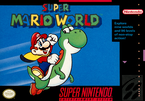 Template:Releasedate SNES |
One year after the release of Super Mario Bros. 3, Super Mario World had been released on a whole new home console — the Super Nintendo Entertainment System. It was with this game that the Mario series had been upgraded from 8-bit to 16-bit graphics. Though the games' graphics would later be revolutionized once again, this was indeed a huge step at the time. During the story of Super Mario World, while Mario, Luigi, and Princess Toadstool were vacationing in Dinosaur Land, Bowser and his seven Koopalings once again kidnapped the Princess. With the help of the Yoshis and Dolphins, the brothers traversed across the vast area of Dinosaur Land. As they made their way to Princess Toadstool, they thwarted each Koopaling who stood in their way until they reached Bowser. Once again, Bowser had been defeated and Princess Toadstool had been rescued. |
| Super Mario 64 | |
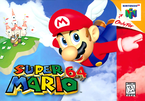 Template:Releasedate Nintendo 64 |
Not long after the release of Super Mario RPG: Legend of the Seven Stars, Nintendo released a new system and a new game — Super Mario 64. The game was a success. It was the first fully 3-Dimensional Mario game to ever be made, thus revolutionizing the appearance of Mario games to date. The game sold over eleven million copies by 2007.[4] Because the game had such amazing success, people began to create rumors of glitches[5] and unlockables in the game. Perhaps one of the most notable rumors was that Luigi was a playable character in the game.[6] This was also the second game to call Princess Peach by her current name (with Yoshi's Safari being the first). In the game, Mario was invited to Princess Peach's Castle to eat a cake she had baked. However, when Mario arrived at her castle, he had discovered that Bowser had taken it over and had stolen almost all of the castle's Power Stars— there were some which he did not know existed. As Mario traversed through fifteen different painting worlds, he eventually recovered enough Power Stars to battle Bowser and take back the castle, freeing Peach from her stained-glass prison. |
| Super Mario Sunshine | |
| File:Box NA - Super Mario Sunshine.png Template:Releasedate GameCube |
In 2002, Mario was back in action in his own three-dimensional platformer once again. While on his way to a vacation with Princess Peach and her loyal steward, Toadsworth, they discover a large glob of Graffiti in the shape of Mario's head at Delfino Airstrip. Mario then finds an interesting machine, called F.L.U.D.D., that helps him rid the island of Graffiti. After he collects a total of ten Shine Sprites, an impostor bearing a striking resemblance to Mario kidnaps Princess Peach. Mario then must redeem his identity (because of Shadow Mario) by ridding the entire island of Graffiti, all the while having to rescue Princess Peach. Towards the end of his adventure, he discovers that Shadow Mario is actually Bowser Jr. in disguise. After fighting Bowser and his son, Mario rescues Princess Peach, finally allowing them to start their vacation. |
| New Super Mario Bros. | |
| File:NewSuperMarioBrothers.jpg Template:Releasedate Nintendo DS |
New Super Mario Bros. is the eighth installment in the Super Mario series. It starts out when Bowser Jr. kidnaps Peach during a strange accident. Luigi is playable in this game, too. Luigi was not playable since Super Mario World. This is the first game since Super Mario World (1990) that features the classic 2D play-style of the Super Mario Bros. games. The game features a solo story mode with Mario or Luigi, a two-player wireless game Mario vs. Luigi, as well as a mini-game mode for up to four players. It was released in 2006 for the Nintendo DS. It spiraled a sequel, New Super Mario Bros. Wii, though that game is not considered to be a direct sequel to the DS game. |
| Super Mario Galaxy | |
| File:SmG.jpg Template:Releasedate Wii |
Super Mario Galaxy is the ninth installment in the Super Mario series and the third 3D game in the series. However, unlike the previous two 3D installments for the Mario series, this game takes place in deep space. Mario attends the Star Festival at the request of Princess Peach, when the town comes under attack by Bowser's air forces. He abducts Peach's entire castle and warps it to the center of the universe, prompting Mario to save her. Most of the game's levels consist of many small planets and planetoids, while others have bigger planets. A new popular species and character appear, Luma and Rosalina. It was released in 2007 for the Wii. This game spiraled a direct sequel, simply called Super Mario Galaxy 2. It is the first 3D game that has done so. |
| New Super Mario Bros. Wii | |
| File:Mariobox-noscale.jpg Template:Releasedate Wii |
The sequel to New Super Mario Bros. for the DS, New Super Mario Bros. Wii was released in November 12, 2009 in Australia. This installment includes four players simultaneously controlling their characters, a feature Shigeru Miyamoto had wanted for years. This game also returns the Koopalings, absent since Mario and Luigi: Superstar Saga, in their first 3-D models. In the story, Bowser and his minions kidnap Peach by using cake as a disguise. Mario, Luigi, Blue Toad, and Yellow Toad travel to eight worlds to save the princess. This game also reintroduces rideable Yoshis, although they can only be ridden in a few levels. The Penguin Suit and the Propeller Mushroom are new power-ups in this game. This game also includes the Super Guide, a demo video for those who are struggling in a particular level. |
| Super Mario Galaxy 2 | |
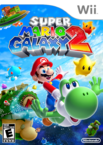 Template:Releasedate Wii |
Super Mario Galaxy 2 is the eleventh installment in the Super Mario series. It is also the fourth 3D game in the series. The sequel contains many elements from its predecessor, such as the story, the adventure being in outer space, recurring objects such as Launch Stars, recurring items including the Bee Mushroom, and the elements of gravity. However, the game introduces new elements such as the utilization of Yoshi and new power-ups such as the Cloud Flower. Rosalina reappears and new characters of the Luma species appear including Lubba. This is the third installment for the Wii in the Super Mario series. |
| Super Mario 3D Land | |
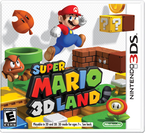 Template:Releasedate Nintendo 3DS |
Super Mario 3D Land is the fifth 3D game in the series, and the twelfth game overall. The levels of Super Mario 3D Land are much more linear and compact than the other 3D titles, more along the lines of the side-scrolling games. Many retro power-ups and characters return, such as Bowser Impostors, the Super Leaf and Boom Boom. New power-ups are also introduced, such as Boomerang Mario, and White Tanooki Mario. It also introduces new enemies and a female partner of Boom Boom named Pom Pom. |
| New Super Mario Bros. 2 | |
| File:NSMB2boxcover.jpg Template:Releasedate Nintendo 3DS |
New Super Mario Bros. 2 is another side-scroller in the series released in 2012 for the Nintendo 3DS. It's the third game in the New Super Mario Bros. line and a direct sequel to New Super Mario Bros. The game features an extremely large amount of coins, which are one of the game's main elements. Raccoon Mario makes a return. A new power-up called the Gold Flower appears and turns Mario into Gold Mario. |
| New Super Mario Bros. U | |
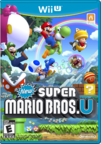 Template:Releasedate Wii U |
New Super Mario Bros. U is a side-scroller for the Wii U. The game seems to borrow some elements from Super Mario World such as Baby Yoshis, Sumo Bros., Bony Beetles, etc. and minor references like diagonal pipes making a return. The game plays very similar to New Super Mario Bros. Wii with its four-player mode, however a player with a Wii U GamePad can create platforms in what Nintendo refers to as "Boost Mode". It is the first Super Mario game (and Mario game overall) to be released in high-definition. The game also introduces a new form, Flying Squirrel Mario. |
| Super Mario 3D World | |
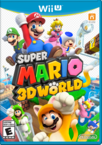 Template:Releasedate Wii U |
Super Mario 3D World is the console follow-up to Super Mario 3D Land. The game's main feature is the Cat Mario transformation, caused by picking up a Super Bell. It also features the entire playable cast of Super Mario Bros. 2 as playable characters, featuring the same abilities they have in said game. The story follows Mario, Luigi, Princess Peach, and Toad as they attempt to rescue the Sprixie Princesses that Bowser has captured and free the Sprixie Kingdom. |
Other original games
| Title | |
|---|---|
| Cover, original release and system | Synopsis |
| Super Mario Bros. Special | |
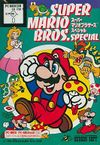 Template:Releasedate X1/PC88 |
Super Mario Bros. Special was made by Hudson Soft for the Sharp X1 and NEC PC88 series of Japanese PCs, and officially licensed by Nintendo. Super Mario Bros. Special was the first licensed sequel to Super Mario Bros. to appear, released a few months before Super Mario Bros.: The Lost Levels in 1986. While superficially very similar to the original Super Mario Bros., the game features original levels but scrolls screen-by-screen rather than smoothly. Jumping and running physics also differ from the original, providing a more challenging experience than Super Mario Bros. Due to the computers' technology being slightly inferior to that of the NES/Famicom, the graphics and audio differ from the original NES game as well, with the X1 utilising more colours and smoother scrolling than the PC88, and does not include Luigi or a multiplayer mode. |
| New Super Luigi U | |
| File:Box NA (final) - New Super Luigi U.png Template:Releasedate Wii U |
New Super Luigi U is a game released to celebrate the Year of Luigi. It reuses most assets from New Super Mario Bros. U, which it was also released as DLC for, but has all-new levels and Luigi supplants Mario as the lead character, with Nabbit becoming the fourth playable character, taking Mario's place. The individually-packaged version was available at retail until the end of the 2013. |
Ports and compilations
| Title | |
|---|---|
| Cover, original release and system | Synopsis |
| Vs. Super Mario Bros. | |
| File:VS.SMB.png Template:Releasedate Arcade Machine |
VS. Super Mario Bros. was a two-player arcade game released in Japan in 1986. The game was mostly the same as the original game; Mario or Luigi went on a quest to save the princess from Bowser and restore order to the Mushroom Kingdom. The game was harder than Super Mario Bros. in that it had fewer warp zones and more enemies, along with options for the arcade owner to make it more difficult still and thus restrict the time an average player got for their money. The game replaced "duplicate" levels from the original with levels which would later be used in the Japanese Super Mario Bros.: The Lost Levels. |
| All Night Nippon Super Mario Bros. | |
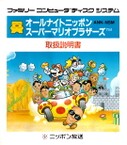 Template:Releasedate Disk System |
All Night Nippon Super Mario Bros. was an officially licensed hack of Super Mario Bros. Gameplay was the same but many characters such as the Mushroom Retainers were replaced with Japanese celebrities from the radio show All Night Nippon. Other changes were also made for this game, such as World 1 being set during night time and Princess Peach's outfit was changed. The game was only released in Japan. |
| Super Mario Bros. (Game & Watch) | |
 Template:Releasedate Game & Watch |
In 1987, two years after the release of Nintendo's first biggest commercial success, the company released a simplified remake of the game on their Game & Watch system. Being a remake of the game, it essentially has the same plot, reduced down to only eight levels; however, after beating every level, they will have to be repeated. Mario will have to go through nine loops, avoiding Lakitus and Bullet Bills, each time with the levels increasing in difficulty. There are also two types of levels: scroll screen levels, in which Mario will have to reach a certain point to advance, and timer screen levels, in which Mario must get through the world in a given amount of time. Additionally, another difference between the original and this remake is that Mario will find Princess Toadstool at the end of every level, without having to fight a boss. |
| Super Mario All-Stars | |
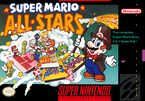 Template:Releasedate SNES |
Super Mario All-Stars, known as Super Mario Collection in Japan, was released in 1993 also for the Super Nintendo Entertainment System. It is a compilation featuring 16-bit versions of the first four main Super Mario series games. Super Mario Bros., Super Mario Bros. 2, Super Mario Bros. 3 and, in its first release outside of Japan, Super Mario Bros.: The Lost Levels. This game updated the four games' graphics and sound to enhance them, with certain changes to the mechanics. A Wii rerelease, called Super Mario All-Stars Limited Edition, occurred in 2010. |
| Super Mario All-Stars + Super Mario World | |
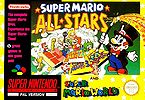 Template:Releasedate SNES |
Super Mario All-Stars + Super Mario World is an America/Europe-only remake of Super Mario All-Stars that also includes Super Mario World for the Super Nintendo Entertainment System. |
| BS Super Mario USA | |
| File:BS SMUSA Mario & Friends.png Template:Releasedate Satellaview |
A pseudo-sequel to Super Mario USA (Super Mario Bros. 2), BS Super Mario USA was released as four installments, and each one involved the player heading into each world to collect a gold Mario statue and defeat the bosses until finally reaching and defeating Wart. Each level could be replayed until the clock reached 50 minutes. As the player progressed, St. Giga's Satellite radio would stream an audio drama to tell the story. After the events of Super Mario Bros. 2, the King of Subcon had golden Mario statues put up all around Subcon, to thank him and his friends for their deeds. However, three Birdos, Mouser, Tryclyde, Fryguy and Clawgrip have stolen them, and now Mario must get them back and defeat Wart again. |
| BS Super Mario Collection | |
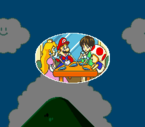 Template:Releasedate Super Famicom |
A remake of Super Mario Collection, (Super Mario All-Stars in North America) BS Super Mario Collection is a game for the Super Famicom add-on Satellaview. Like with BS Super Mario USA, as the player progressed through the game, voice acting and music would be streamed to the system using the Satellaview's Soundlink capabilities. |
| Super Mario Bros. Deluxe | |
| File:SMBDX Boxart.PNG Template:Releasedate Game Boy Color |
Super Mario Bros. Deluxe is a Game Boy Color remake which includes the first two Super Mario games ever released: Super Mario Bros. and Super Mario Bros.: The Lost Levels (that last under the name of Super Mario Bros.: For Super Players). Besides those games, it also featured many other collectibles, including images that could be printed with the Game Boy Printer, Cable Link interface multi-player, records sharing by infrared connection, a calendar, a fortune teller, etc. Unlike other remakes, it wasn't developed by Nintendo EAD, but by Nintendo R&D2. |
| Super Mario Advance | |
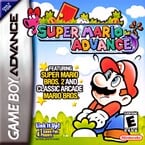 Template:Releasedate Game Boy Advance |
Super Mario Advance is a remake of Super Mario Bros. 2 made for the handheld game system, the Game Boy Advance, and released in 2001. Like the Super Mario All-Stars port, Super Mario Advance had updated graphics. |
| Super Mario World: Super Mario Advance 2 | |
| File:Box NA - Super Mario World Super Mario Advance 2.png Template:Releasedate Game Boy Advance |
Super Mario World: Super Mario Advance 2 is a remake of Super Mario World made for the Game Boy Advance. It was the second title in the Super Mario Advance series and was released in 2002. There are various differences between the original Super Mario World and Super Mario Advance 2. The game was a gigantic hit for Nintendo and the Game Boy Advance, selling 3,290,000 copies in the United States and 5,460,000 copies worldwide. Additionally, Luigi's sprite has been changed and made taller than Mario to match his normal appearance, and the Mario Bros. classic game has been included in the game (like the other Mario Advance games), with multiplayer playable. |
| Super Mario Advance 4: Super Mario Bros. 3 | |
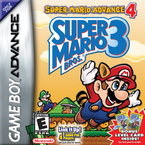 Template:Releasedate Game Boy Advance |
In 2003, the fourth entry in the Super Mario Advance series, Super Mario Advance 4: Super Mario Bros. 3, was released for the Game Boy Advance. It boasted similar graphics and sound to the Super Mario All-Stars version, and made use of the e-Reader. A few e-cards came included with new copies of the game, while two sets (referred to as "series") of cards, were released and sold alongside the game. By scanning special cards into the e-Reader, players were able to upload items, videos, and most importantly, new levels into the game. One notable item was the Cape Feather from Super Mario World, which allowed Mario to transform into Cape Mario. There were also two Switch cards that the player could activate (and deactivate) the effects of by scanning them; the Orange Switch and the Blue Green Switch. Scanning these switches triggered small functions in the game. The e-Reader feature is still available in the European version, but it is disabled by default and unable to access. |
| Classic NES Series: Super Mario Bros. | |
| File:CNS-SMB Cover.jpg Template:Releasedate Game Boy Advance |
The original NES version of Super Mario Bros. was released for the Game Boy Advance as part of the Classic NES series of games in commemoration for the 20th anniversary of the release of the original Famicom and NES. It is a direct port, and as a result features no new additions or bugfixes. Consequently, the only significant difference is that the graphics were downscaled to fit the GBA screen resolution. |
| Famicom Mini: Super Mario Bros. 2 | |
| File:FM Super Mario Bros 2 JAP cover.jpg Template:Releasedate Game Boy Advance |
In Japan, the Classic NES Series were known as Famicom Mini. The original Super Mario Bros. 2 (known in western regions as Super Mario Bros.: The Lost Levels) was released only in Japan. Much like Super Mario Bros., it didn't feature any new additions, the bugs were left untouched, and the graphics were down-scaled. |
| Super Mario 64 DS | |
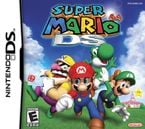 Template:Releasedate Nintendo DS |
Super Mario 64 DS is a remake of Super Mario 64. It was released in 2004 for the Nintendo DS. It is also the first Mario game released for the Nintendo DS. Though it is a remake, there are many differences between it and the original (four playable characters and 30 new Power Stars are two examples of this). The game begins the same as the old one; Peach invites Mario to the castle for cake. However, instead of just Mario, Wario and Luigi come for cake, while Yoshi sleeps on the roof of the castle. Bowser then takes over the castle, captures Peach, and locks Mario, Luigi, and Wario inside three rooms. Lakitu then wakes Yoshi up, and now he has to save Mario and the others in order to save the princess once again, this time through teamwork. |
| Super Mario All-Stars Limited Edition | |
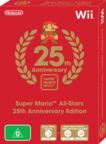 Template:Releasedate Wii |
Released for the Wii in 2010, Super Mario All-Stars Limited Edition celebrates the 25th anniversary of Mario featuring the same games as mentioned in the All-Stars section. It is a port of the original game Super Mario All-Stars. |
| New Super Mario Bros. U + New Super Luigi U | |
| File:Box NA - New Super Mario Bros. U + New Super Luigi U.png Template:Releasedate Wii U |
A compilation of both New Super Mario Bros. U and New Super Luigi U on the same disc, initially released exclusively with the Mario & Luigi Deluxe Wii U set (known as the Premium Pack in Europe). New Super Mario Bros. U + New Super Luigi U includes notable changes to the originals, including a new title screen and over 200 videos included as bonus content.
This compilation was released separately as a Nintendo Select title in 2016. |
Characters
This section is under construction. Therefore, please excuse its informal appearance while it is being worked on. We hope to have it completed as soon as possible.
Main protagonists
| Character | ||
|---|---|---|
| Image | Brief biography | First appearance |
| Mario | ||
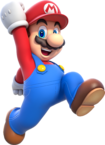 |
Mario is the main protagonist in his titular series of games. Throughout almost thirty years, Mario has been the star of the largest game franchise Nintendo has published. Many characters have fought alongside Mario in his adventures in platformers and RPGs, but many have also fought against him during those times. Mario has gone through many physical changes, from his original 8-bit appearance, to his current 128-bit appearance. Mario commonly rescues Princess Peach, as well as several others, such as Mushroom Retainers, as his adventures continue. Mario has even been accepting enough to team up at times with his greatest foe, Bowser. | |
| Luigi | ||
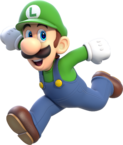 |
Luigi is Mario's taller, younger, twin brother. Luigi first debuted alongside Mario in Mario Bros. in 1983, fighting off the many enemies as a plumber. Luigi reappeared in Super Mario Bros. for the NES, playable only in the two-player mode of the game. He later appeared in Super Mario Bros. 2, being playable in one-player mode for the first time along with Toad and Peach. Luigi has appeared in many of Mario's games, but there were some from which he was excluded — among which are Super Mario Land and Super Mario 64. | |
| Princess Peach | ||
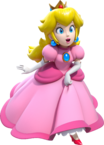 |
Princess Peach — originally "Princess Toadstool" — is the damsel-in-distress of the series. Princess Peach is the ruler of the Mushroom Kingdom, and is protected by many Toads. However, her protection commonly fails and eventually results in her being kidnapped, be it by Bowser, or by another villain. In Super Mario Bros. 2 and Super Mario 3D World, Peach is one of the playable characters and one of the main protagonists. | |
| Toad | ||
 |
Toad originally played the role of Princess Peach's assistant, as well as her guide and guardian throughout her travels; however, he has been reduced to lesser roles since his debut appearance, with his role in main games having been replaced by Toadsworth. His first playable appearance was in Super Mario Bros. 2 and reappear again in Super Mario 3D World. Though he appears identical to many others in his species, Toad is actually an entirely different character; this causes much confusion as to whether or not certain Toads are the Toad discussed. | |
| Yoshi | ||
 |
Yoshi is Mario's dinosaur companion and one of his most trusty allies during his adventures. In many games Yoshi is present, he is always disposed to give Mario a ride on his back; while riding him and under Mario's command, Yoshi can use his long chameleon-like tongue to swallow a diverse variety of objects, including enemies. Yoshi also supports additional abilities Mario is unable to do on his own like Yoshi's signature Flutter Kick. Super Mario 64 DS features Yoshi as a standalone playable character, meaning it is not necessary for Mario to ride him. In fact, the game opens with Yoshi as the sole playable character that needs to rescue Mario and co. Though he lacks power, he compensates this with his ability to swallow enemies and turn them into an egg, which in turn serves as a homing projectile to take out several enemies at once. | |
| Wario | ||
| File:WarioGoodQual.PNG |
Wario is Mario's yellow-clad, greedy rival. Though he has antagonized Mario since his debut in Super Mario Land 2: 6 Golden Coins, Wario proved to be a valuable ally during the events of Super Mario 64 DS, where he, alongside Luigi, originally came to "crash the party" of Mario and Peach. Wario is the strongest character in the game, being able to destroy some obstacles the other character would have no choice but avoid them. | |
| Yellow Toad | ||
| File:Yellow Toad NSMBW.png |
Yellow Toad appears in New Super Mario Bros. Wii as one of the main protagonists along with Mario, Luigi and Blue Toad. He reprises is role in New Super Mario Bros. U as one of the four main protagonists with Mario, Luigi and Blue Toad. | |
| Blue Toad | ||
| File:Bluetoad2.png |
Blue Toad first appeared in New Super Mario Bros. Wii as one of the main protagonists along with Mario, Luigi and Yellow Toad. He reprises is role in New Super Mario Bros. U as one of the four main protagonists with Mario, Luigi and Yellow Toad. | |
| Rosalina | ||
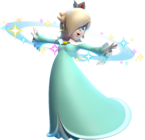 |
Rosalina debuted in Super Mario Galaxy. She reappears as a playable character in Super Mario 3D World, which makes her the second female protagonist along with Princess Peach. She is the adoptive mother of the Lumas, which are also popular to Super Mario Galaxy. Her main duty is to watch the Lumas and help keep the galaxies safe. Throughout Super Mario Galaxy, Rosalina gives helpful and important advice and tips to Mario. | |
Main antagonists
| Character | ||
|---|---|---|
| Image | Brief Biography | First Appearance |
| Bowser | ||
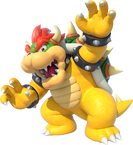 |
Bowser is the main antagonist throughout the Super Mario series. He first appeared in Super Mario Bros. for the NES, having kidnapped Princess Toadstool. He is the King of all Koopas, and is found to be the final boss in almost all platformers. | |
| Wart | ||
| File:Wart Artwork - Super Mario Bros 2.png |
Wart is the main antagonist and final boss of Super Mario Bros. 2. He is leader of the 8 bits, an evil organization that set to conquer the land of dreams known as Subcon. | |
| Koopalings | ||
| File:Koopalings - New Super Mario Bros U.png |
The Koopalings are introduced as Bowser’s children in Super Mario Bros. 3 and then considered Bowser's minions from New Super Mario Bros. Wii onwards. They are bosses in various games. Their names are Larry Koopa, Roy Koopa, Iggy Koopa, Wendy O. Koopa, Lemmy Koopa, Morton Koopa Jr. and Ludwig von Koopa. | |
| Bowser Jr. | ||
| File:Bowserjr MP9.png |
Bowser Jr. is Bowser's son and first appears as the main antagonist in Super Mario Sunshine and then throughout the Super Mario series as one of the main bosses. He kidnapped Princess Peach who he thought she was his mother. He is the heir to the Koopa throne. | |
| Kamek | ||
| File:Kamek-212x283.png |
Kamek is an old, yet powerful Magikoopa and apparent advisor to Bowser (or at least high-ranking member in the Koopa Troop). He is sometimes the main antagonist in the Yoshi series while being one of the main bosses in the Super Mario series. | |
| Boom Boom | ||
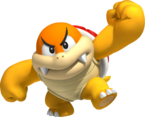 |
Boom Boom is one of Bowser's henchmen. He is an antagonist in the Super Mario series. Boom Boom first debuted in Super Mario Bros. 3, where he battles Mario or Luigi in fortresses, Boom Boom then later made his return appearance in Super Mario 3D Land as one of the game's main antagonists who often appears in airships, along with his partner Pom Pom. | |
| Pom Pom | ||
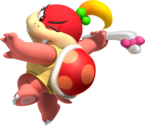 |
Pom Pom often appears on airships where she could fight Mario or Luigi. Pom Pom shares her name with a loose, fluffy material used by cheerleaders and sports fans, or in crafts, the pom-pom. She is related to Boom Boom . | |
| Dry Bowser | ||
| File:Dry Bowser MSOWG.jpg |
Dry Bowser is the undead and skeletal version of Bowser. He made his debut in New Super Mario Bros., where he came about as the result of Mario defeating Bowser by dropping him into lava at the end of New Super Mario Bros.'s first castle. However, both in New Super Mario Bros. 2 and Super Mario 3D Land, Dry Bowser appears even though Bowser isn't turned into a skeleton when he falls into the lava at the end of the final boss battles[7][8]. | |
See also
References
- ^ http://www.gameinformer.com/b/features/archive/2012/09/24/miyamoto-tezuka-interview.aspx
- ^ Best-selling NES game
- ^ Extreme difficulty of Super Mario Bros.: The Lost Levels
- ^ Super Mario 64 sales results
- ^ Rumored glitches in Super Mario 64
- ^ Rumors of Luigi in Super Mario 64
- ^ GameXplain (August 17, 2012). New Super Mario Bros 2: Ending & Credits (Spoilers!). Youtube. Retrieved April 22, 2016).
- ^ ❤Sunny❤ (February 17, 2016). Super Mario 3D Land - Final Boss Battle & Ending. Youtube. Retrieved April22, 2016.